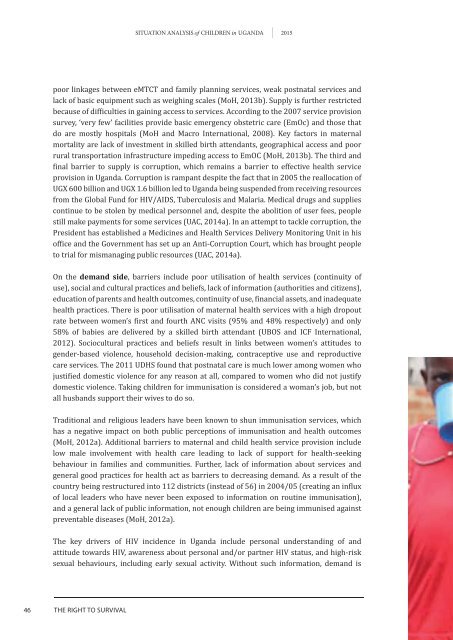Situation analySiS
1TNu802
1TNu802
Create successful ePaper yourself
Turn your PDF publications into a flip-book with our unique Google optimized e-Paper software.
<strong>Situation</strong> <strong>analySiS</strong> of Children in uganda 2015poor linkages between eMTCT and family planning services, weak postnatal services andlack of basic equipment such as weighing scales (MoH, 2013b). Supply is further restrictedbecause of difficulties in gaining access to services. According to the 2007 service provisionsurvey, ‘very few’ facilities provide basic emergency obstetric care (EmOc) and those thatdo are mostly hospitals (MoH and Macro International, 2008). Key factors in maternalmortality are lack of investment in skilled birth attendants, geographical access and poorrural transportation infrastructure impeding access to EmOC (MoH, 2013b). The third andfinal barrier to supply is corruption, which remains a barrier to effective health serviceprovision in Uganda. Corruption is rampant despite the fact that in 2005 the reallocation ofUGX 600 billion and UGX 1.6 billion led to Uganda being suspended from receiving resourcesfrom the Global Fund for HIV/AIDS, Tuberculosis and Malaria. Medical drugs and suppliescontinue to be stolen by medical personnel and, despite the abolition of user fees, peoplestill make payments for some services (UAC, 2014a). In an attempt to tackle corruption, thePresident has established a Medicines and Health Services Delivery Monitoring Unit in hisoffice and the Government has set up an Anti-Corruption Court, which has brought peopleto trial for mismanaging public resources (UAC, 2014a).On the demand side, barriers include poor utilisation of health services (continuity ofuse), social and cultural practices and beliefs, lack of information (authorities and citizens),education of parents and health outcomes, continuity of use, financial assets, and inadequatehealth practices. There is poor utilisation of maternal health services with a high dropoutrate between women’s first and fourth ANC visits (95% and 48% respectively) and only58% of babies are delivered by a skilled birth attendant (UBOS and ICF International,2012). Sociocultural practices and beliefs result in links between women’s attitudes togender-based violence, household decision-making, contraceptive use and reproductivecare services. The 2011 UDHS found that postnatal care is much lower among women whojustified domestic violence for any reason at all, compared to women who did not justifydomestic violence. Taking children for immunisation is considered a woman’s job, but notall husbands support their wives to do so.Traditional and religious leaders have been known to shun immunisation services, whichhas a negative impact on both public perceptions of immunisation and health outcomes(MoH, 2012a). Additional barriers to maternal and child health service provision includelow male involvement with health care leading to lack of support for health-seekingbehaviour in families and communities. Further, lack of information about services andgeneral good practices for health act as barriers to decreasing demand. As a result of thecountry being restructured into 112 districts (instead of 56) in 2004/05 (creating an influxof local leaders who have never been exposed to information on routine immunisation),and a general lack of public information, not enough children are being immunised againstpreventable diseases (MoH, 2012a).The key drivers of HIV incidence in Uganda include personal understanding of andattitude towards HIV, awareness about personal and/or partner HIV status, and high-risksexual behaviours, including early sexual activity. Without such information, demand is46 thE rIGht to SUrvIvaL




